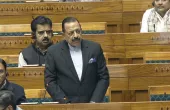
Permit processes need streamlining to drive APAC’s wind energy growth
A ‘route-to-market’ approach will help emerging markets boost their offshore wind capacity, says expert.
Despite a historic year for wind energy installation, the growth led by the Asia Pacific region in 2023 falls short of the target to triple global renewable energy (RE) capacity. To accelerate the sector’s growth, markets, especially emerging ones, should adopt an approach to streamline processes for offshore wind development.
Liming Qiao, head of Asia at the Global Wind Energy Council (GWEC), said that for the onshore wind sector, there are already established policy frameworks and supportive mechanisms such as feed-in-tariff and auctions to drive its growth.
However, for the offshore wind sector, permitting processes remain one of the key barriers and this could be resolved through the implementation of a “route-to-market” strategy.
“[Route-to-market] is basically to put all the different key elements about permitting, offtaking, leasing, and planning, everything into a big framework so that [markets] can hit and go and enable the investment and installation of renewables to happen,” Qiao told Asian Power.
The planning under the route-to-market strategy, refers to the marine spatial planning for offshore wind, whilst the leasing pertains to securing the seabed where the offshore project will be built. The off-taker mechanism covers strategies such as feed-in-tariff and auctions.
“For the offshore [wind industry], the majority of the market, apart from China and Taiwan, are emerging or new offshore markets. This means that the bigger policy framework, the route-to-market, is not there,” she said.
However, she also noted that some emerging markets are moving towards implementing this strategy. She cited the Philippine government, which launched Executive Order No. 21 last year to establish a policy and administrative framework for offshore wind development.
Under the executive order, the Philippines’ Department of Energy is mandated to integrate all the identified processes of offshore wind development into the Energy Virtual One-Stop Shop which will be used by permitting agencies to accommodate developers’ permit applications.
This move will support the Philippines’ goal of increasing its renewable energy capacity to 35% by 2030 and 50% by 2040 from the current 22%.
Ambitious national targets, Qiao said, are needed to drive the tripling of renewable energy targets.
“Fortunately [this is] something that we see happening now. It happens for [either] onshore or general renewable targets,” Qiao said. “We also see it specified to the offshore industry in markets such as China, Japan, Vietnam, the Philippines and South Korea.”
APAC’s wind landscape
According to GWEC, the wind market accounted for 117 gigawatts (GW) out of the 510 GW of new renewable energy installations in 2023.
The new wind installation represents a 13% year-on-year growth, bringing the total wind power capacity to around one terawatt. Onshore wind comprised the majority of the wind installations at 106 GW or a 54% year-on-year (YoY) increase.
The APAC region led the onshore wind industry growth with 75 GW of new installations, led by China which commissioned more than 69 GW. This is followed by Latin America with 6 GW of new capacity.
Offshore wind capacity, meanwhile, rose by 24% YoY or around 10.8 GW, bringing the total capacity to 75.2 GW.
China also led the annual offshore wind development for the sixth consecutive year with 6.3 GW of capacity connected to the grid in 2023.
Aside from China, three other markets commissioned new offshore wind capacity in the APAC region led by Taiwan with 692 megawatts (MW), Japan with 62 MW and South Korea with 4 MW.
Developing supply chain
To further accelerate the growth of the wind sector in the region, Qiao said that it is important to develop the supply chain.
“Supply chain is going to be one of the bottlenecks going forward,” she said. “Supply chain development would take some time, and partly also because quite some of the supply chain currently is very much dominated in a few markets, some in Europe and some in China.”
The GWEC report states that there is a “strong focus” in China in terms of the wind supply chain, noting that the country has developed a “scale-drive and backwards integrated industry through steady market expansion” in the last decade.
China is leading in material refining, and manufacturing of key wind components such as gearboxes, converters, generators, and castings. Whilst the country produces mostly for local wind projects, China accounts for 64% of the total value generated across the wind energy supply chain.
Still, Qiao views that trade tensions between China and the US, and between China and Europe, are already affecting the bigger clean energy industry.
Whilst its effects are not overspilling into the wind sector, further deterioration of the trade tensions could eventually affect the wind energy supply chain.
“If that really happens, that will put lots of pressure on the supply chain movement, and also on the supply chain availability, and also on the cost of the products that are coming from the supply chain. That is why we need diversification [in the supply chain,” Qiao said.
“We are actually advocating for global cooperation based on established norms for trade and also building the regional supply chain to be competitive and resonant to any of the changes here.” she added.
In April, GWEC expressed its support for fair and transparent trade practices in the wind industry as this will help in achieving energy transition goals. Unnecessary restrictions will only push up costs, slowing down deployment and the shift to clean energy, it added.
GWEC noted that competition is essential, encouraging the industry and governments to work together in resolving issues through dialogue and evidence-based negotiation.



















 Advertise
Advertise






